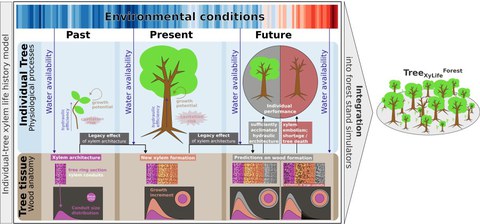Dec 01, 2024
New research project funded by the DFG: 'XyLife'

Concept of the envisaged study, integrating life history-specific patterns of xylem formation into individual-tree models in order to advance our understanding of the drivers, magnitude and consequences of intra-specific variation in hydraulic traits of trees of different origin, and how this possibly affects forest composition and functioning in the long term, i.e. under climate change.
Title:
Individual-based modelling of xylem life history to advance projections of tree responses to climate change - XyLife
Duration: 3 years
PI: Dr. Martin Zwanzig
The intensity and frequency of droughts have increased dramatically in the last decade and many forests have shown a high vulnerability, but the responses are complex and not uniform, also not for trees of the same species. To understand how trees will respond to future climatic conditions, it is of paramount importance to consider and understand their phenotypic plasticity, specifically of hydraulic traits of the xylem in response to the course of environmental conditions a tree experiences over its lifetime. This still represents an open challenge and specifically calls for individual-based models, as such mechanistic models allow traits to be modeled as emerging properties based on the underlying first principles, consequently also facilitating model transferability.
| With the XyLife project, we intend to extend the knowledge and process understanding of the interactions between tree growth, hydraulic architecture, and water availability by adopting patterns of wood anatomy for the development of a new individual-based xylem growth model and implementing it in existing forest simulation models. |
To develop the individual-based xylem growth model, we will systematically test empirically derived hypotheses on the interaction of processes, i.e. water availability, xylem formation, embolism, hydraulic conductance, and tree growth. This work will be based on an already developed model prototype and finally used to simulate the individual, yearly plastic change of xylem properties in response to the dynamics in environmental conditions. Long-term wood anatomical data from provenance experiments of Fagus sylvatica and Quercus rubra will be used for model fitting and cross-validation, allowing us to determine under which definitions of the xylem formation processes under consideration the model corresponds to the observed temporal patterns. It will, more specifically, also allow us to parameterize the model to both diffuse- and ring-porous-specific types of xylem formation and to characterize provenance-specific plasticity in xylem formation. The individual-based xylem growth model will further be used to identify opportunities and risks of differently plastic xylem formation behaviors under varying scenarios of climate change by simulation experiments scaling up from individual trees to individual-based competition of trees within forest stands. For the latter, the xylem growth model will be provided as a building block to the pyMANGA simulation environment, allowing the integration of the xylem growth model into an already existing forest stand simulator. With this extension to the stand scale, the local competition of many trees with simultaneously evolving xylem characteristics will be simulated and used to identify life history trade-offs of contrasting types of xylem formation behavior in varying tree community compositions relevant for resiliencing future forest ecosystems.
